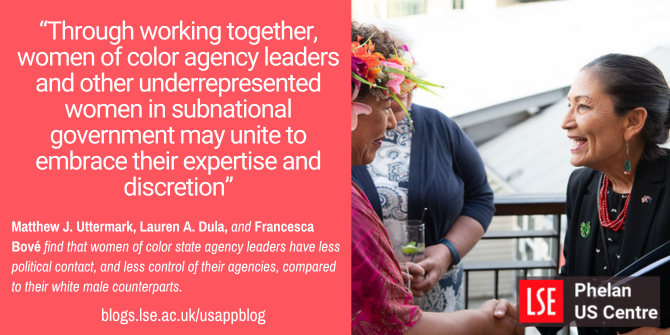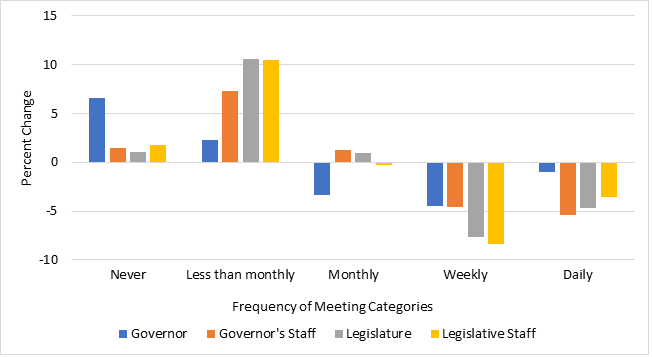

 The appointed heads of state and federal agencies have discretion in how they run their organizations and implement legislation, within the bounds of oversight from elected officials. In new research Matthew J. Uttermark, Lauren A. Dula, and Francesca Bové use an intersectional perspective to examine how women of color state agency leaders exercise their authority in terms of their contact with elected officials and decision-making power. They find that women of color agency heads report less frequent meetings with their elected officials but are more likely to say that these officials exert greater control over their agencies compared to agency heads who are white men or white women. They suggest that to create a more equitable working environment for women of color agency heads, elected officials and their staff should undergo DEI training and a new national association for bureaucrats who are women of color should be established.
The appointed heads of state and federal agencies have discretion in how they run their organizations and implement legislation, within the bounds of oversight from elected officials. In new research Matthew J. Uttermark, Lauren A. Dula, and Francesca Bové use an intersectional perspective to examine how women of color state agency leaders exercise their authority in terms of their contact with elected officials and decision-making power. They find that women of color agency heads report less frequent meetings with their elected officials but are more likely to say that these officials exert greater control over their agencies compared to agency heads who are white men or white women. They suggest that to create a more equitable working environment for women of color agency heads, elected officials and their staff should undergo DEI training and a new national association for bureaucrats who are women of color should be established.
In March of 2021, Deb Haaland was confirmed by the US Senate to serve as the Secretary of the Interior. Haaland— a member of the Laguna Pueblo tribe—is the highest-ranking Indigenous woman in the federal government. While debating Haaland’s nomination, Democratic Senator Tina Smith of Minnesota confronted her Republican colleagues for holding “women of color to ‘a different standard’ than they would have for a white man” stating: “‘We have got to come to grips with the reality that time after time, strong women—and especially women of color—are attacked when white men with the same views are welcomed to walk right through the door, unopposed’”
In new research we look at state agencies and begin to explore the barriers that women of color agency heads face within the US. We evaluate these barriers through an intersectional lens – highlighting that individuals’ multiple social identities can intersect with various systems of oppression to create distinct challenges. Evaluating several waves of the newly public American State Administrators Project (ASAP) survey, we find that women of color state agency directors report less contact with their electoral supervisors, yet feel they have less control over their agency compared to their white and male peers.
Examining bureaucrats’ intersectional identities
The delegation of decision-making from elected officials to federal and state executive branch agencies is part of our national legal process, though this is not explicitly set out in the Constitution. The Supreme Court has decided that agencies can exert their discretion in implementing legislation in cases such as 1984’s Chevron USA. Inc., v. Natural Resources Defense Council and more recently in 2019 – Gundy v. United States. Agencies therefore are inherently centers of power. However, as the leadership of agencies continues diversifying, we questioned whether individuals’ social identities change how much political oversight they encounter, and therefore how much discretion they perceive they have.
Black feminist Kimberle Crenshaw (1989) introduced the term intersectionality to conceptualize how multiple social identities and the various systems of oppression attached to them intersect to unique, distinct challenges that are present for an individual in society. Subsequent studies demonstrate how the societal dominance of white, heterosexual US men has sustained the oppression and leadership experiences of those with intersecting identities, like women of color. Historically, the stereotypical bureaucrat and politician was a white man, and studies have found that being visibly in the demographic minority highlights this hegemony in high levels of government. This is why we focused on this particular population of bureaucrats.
Communication between bureaucrats and elected officials and their staff can have meaningful implications for policy decisions and outcomes. However, little is known about how bureaucrats who identify with underrepresented groups communicate with those who oversee them politically. Some studies find that women of color are making representational strides in the public versus for-profit sector, yet as Sofia Calsy and Maria J. D’Agostino of CUNY John Jay College explain that progress for women of color in the public sector is elusive in their involvement with decision-making, stating that “structures of decision making and patterns of interaction have replaced racism and sexism as the frontier of inequality.” Research on women and people of color within superior-subordinate relationships reveals that racial representation for underrepresented constituents and public service employees is important for communication with a superior. This similarity is difficult to find for underrepresented groups in the US government.
The role of oversight then extends further into the realm of the perception of power for leaders. In the United States, governors and state legislators have oversight power over state agencies, and state employees believe that these actors in turn have significant influence and control over them. Interestingly, it has been found that women in positions of power or leadership practice rely on the rules more so than women lower in organizational hierarchies. While women and people of color have been found to rely on rules, it minimizes their own perceived authority. Given both the research on oversight and discretion of bureaucrats and the intersectionality of identities, we hypothesized that women of color would experience less contact yet feel they have disproportionately less decision-making power than their white and male agency leader counterparts.

“Visit of Department of Interior Secretar” (Public Domain) by US Embassy New Zealand
Analyzing the experiences of women of color agency heads
To evaluate our hypotheses, we rely on several waves of the ASAP survey fielded between 1974 and 2008. The ASAP survey is a nationally representative survey sent to administrative agency heads in all 50 states which measures their experiences, tasks, and perceptions of government.
In our analysis, we compare the experiences of women of color agency heads to those of white men, white women, and men of color agency heads. We first investigated if women of color agency heads report different levels of contact with higher-ups in state government. We found that women of color agency heads report less frequent meetings with their elected officials– governors, legislators, and their staff – compared to agency heads of other gender-race combinations. A woman of color administrator is more likely to never, or infrequently, meet with these individuals compared to other administrations. Our findings hold when accounting for additional factors such as the administrator’s experience, education, agency, and state political ideology.
Figure 1 – Women of color agents’ contact with supervisors compared to white men agents

We then examined if women of color leaders perceive having less discretion over their agency. We evaluated survey questions that ask administrators how much power they think the state legislature or governor has over public policy decisions and regulations. We find that women of color administrators are significantly more likely to state that elected officials exert more control over their agencies compared to agency heads who are white men or white women.
Ensuring agency leaders from underrepresented groups feel they have discretion in their leadership.
At the practical level, we provide several best practices to help create a working environment where all underrepresented groups feel that they have equitable perceptions of discretion as their white and man counterparts.
First, the onus to improve communication and perceptions of agency control and create a more equitable workplace should not be placed upon underrepresented groups. We recommend that elected officials and their staff should undergo training upon election or appointment. At the national level and in several states, employees are required to participate in DEI training, however, this is not the case for elected officials. Training should focus on both how to best work with and supervise state agents as well as diversity, equity, and inclusion issues. We also recommend that training be codified into state policies to encourage compliance of elected officials and – due to term limits – that training is mandated biennially.
Second, we recommend identifying additional means to empower women of color in state governments who are distinctly in the minority of state agency leadership positions. There are already associations for Black bureaucrats, but no national association for bureaucrats who are women of color. Making space for administrators to organize in this way can provide a networking system that could help in communicating more effectively with elected officials.
Through working together, women of color agency leaders and other underrepresented women in subnational government may unite to embrace their expertise and discretion.
- This article is based on the paper ‘Contact and control: Engagement and influence among women of color state agency heads’, in Public Administration Review.
- Note: This article gives the views of the author, and not the position of USAPP – American Politics and Policy, nor the London School of Economics.
- Shortened URL for this post: https://bit.ly/3G83zPg






